Calendars
Purpose: The menu Calendars is used for:
- Creating shift templates with working hours and breaks for the week
- Assigning shift template to machine
- Removing shift template from machine
Select the menu Planning>Calendars.
- The page Calendars, tab Machine calendar is opened

Figure 1: Planning - Calendars
Create a new shift template
Purpose: Creating a new empty template for a shift.
For creating a new template select tab Create template.

Figure 2: Calendars – create template
Enter the name of the template and click the button Create.
- There is created an empty template with the entered name
A new template is possible to create by entering name and selecting from the list Copy from shift template the existing template.
- There is created a template with entered name, that is equal to the selected template from the list
The created new template is visible in the list of the tab Templates.
Filling the template with shift hours
Purpose: The page Templates is used for:
- Review the list with templates
- Review and plan the shift graphics with working hours and breaks
- The shift template is planned for the selected time zone
- Deleting the selected template
- Updating hours/breaks for the selected template
Click on the tab Templates.
- There is shown the list with created shift templates
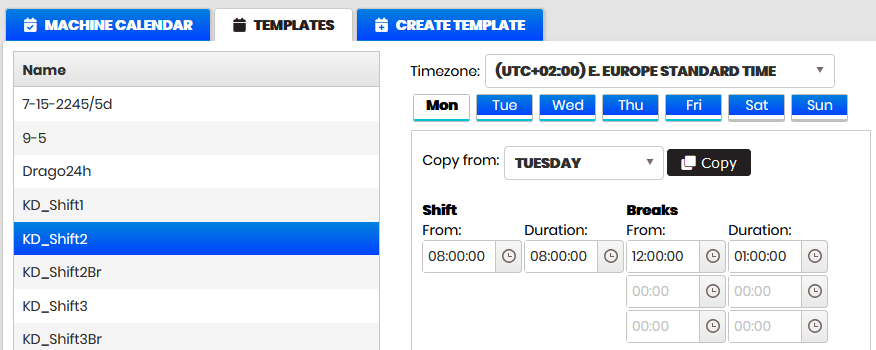
Figure 3: Calendars – planning the template schedule
Select shift template from the list
- At the right is shown form for entering working hours (From, Duration), breaks (From, Duration), and Timezone. Monday is selected by default.
Enter for Monday in the Shift fields From hours and Duration hours selected from the dropdown list or typed manually in the fields.
Enter breaks (if necessary) in the Breaks fields similarly.
- The shift graphic for Monday is ready
For the rest days of the week is possible to copy hours from already configured Monday.
Click on Tue (Tuesday), Copy from is loaded with Monday. Click button Copy.
- The shift for Tuesday is copied from Monday.
Repeat the step with the selected next day from the week (Wed, Thu, Fri) and copy the shift.
The choice of time zone affects the visualization in the plan and therefore it is necessary to choose correctly.
For Bulgaria select (UTC+02:00) E. EUROPE STANDARD TIME.
Click the button Save.
- The created shift template with hours and time zone is saved.
The created template is possible to delete from the list. Select the template from the list and click the button Delete.
- The selected template is removed from the list.
The planned hours in the template are possible to change many times and respectively save by clicking on the Save button.
Assign shift template to machine
Purpose: Assign a shift template to a machine.
Click on the tab Machine calendar.
- The list with machines is shown
- In front of the machine number is shown an icon:
- Red cross icon - if there is no attached schedule
- Green icon with a checkmark - if there is an attached schedule.
Select a row with a machine without attached shift template (has a red icon).
- At the right appear forms Current calendar and Next calendar.
Open the templates dropdown in the Current calendar and select shift template.
In the field Active from select date and hour from which the schedule will be active.
It is possible to fill in the Next calendar template, date and hours from which the schedule will be active.
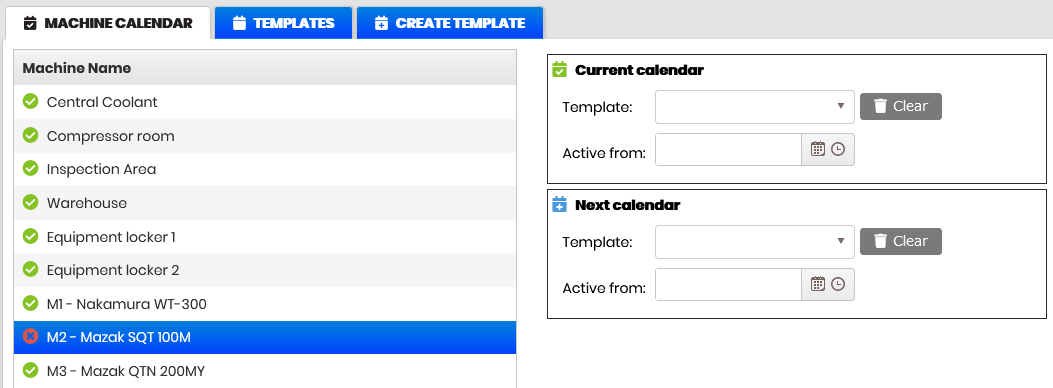
Figure 4: Calendars - machine calendars
- The icon in front of the machine number and name becomes green which means that a schedule is already attached.

Figure 5: Calendars- machine with assigned shift template
Removing shift template from machine
Цел: Removing shift template from the machine. Then is possible again to assign a new shift template.
Click on the tab Machine calendar. Select machine from the list with a green icon. In the field Current calendar is visible the shift template name and date and time from which the schedule is active.
Click the button Clear. Confirm clearing the schedule with button Delete.
- The fields in the form Current calendar are cleared and icon in front of the machine number and name becomes red.
To machines without attached shift templates is possible to assign new shift templates.
Operations
Purpose: Review and filter the imported from the ERP operations that will be scheduled as production orders. The section is possible to collapse to increase the area of the plan with production orders by machine.
Preconditions: Planned in the ERP operations for orders and details are imported automatically in the Upkip platform.
Select the menu Planning > Production orders.
- There is opened the page for review and filtering of the operations imported from the ERP. Visually selected operations will be planned by dates and machines.

Figure 6: Planning – operations from ERP
The table with operations is shown at the top part of the page. Each operation is shown on one row with data in the columns: order (number), part (number), operation (number), name (operation name), product (name), customer (name), date and time of the planned start and end of the operation.
To show the operation status row is colored with different colors (see legend) – not planned (white), planned (yellow), started (light green), overdue (pink), closed (dark green).
Filtering operations
For filtering operations are used multiple filters:
- Filter by period From – To.

Figure 7: Operations – filter by period
- With checked and selected both dates are shown all operations with a planned start greater than the first and planned end smaller than the second date.
- With checked only first date are shown all operations with a planned start greater than selected date.
- With checked only second date are shown all operations with planned end smaller than selected date.
- Filter by order, name, product, and client.

Figure 8: Operations – filter by order, name, product, customer
Enter in the filter Order part of the order name.
- The table with operations is filtered automatically showing only the operations to orders containing in the order name entered text.
Enter in the filter Name part of the operation name.
- The table with operations is filtered automatically showing only operations with a name containing the entered text.
Enter in the filter Product part of the product name.
- The table with operations is filtered automatically showing only operations to products containing in the product name entered text.
Enter in the filter Customer part of the customer name.
- The table with operations is filtered automatically showing only operation to products for customers containing in the customer name entered text.
Operations can be filtered by the filter Active or Closed selected from the dropdown filter.
- The table with operations is filtered automatically.
Collapse/Expand the table with operations
It is possible to expand or collapse the table with operations from the ERP clicking on the right side icon.

Figure 9: Planning - collapsed operations table
If collapse the main menu and operations table the whole screen will be used for the Gantt with planned operations by machine.
Review details of the planned operation
Precondition: The operation has been planned by date and machine.
If operation has planned at the right column appears icon with tooltip Status and link Show details.
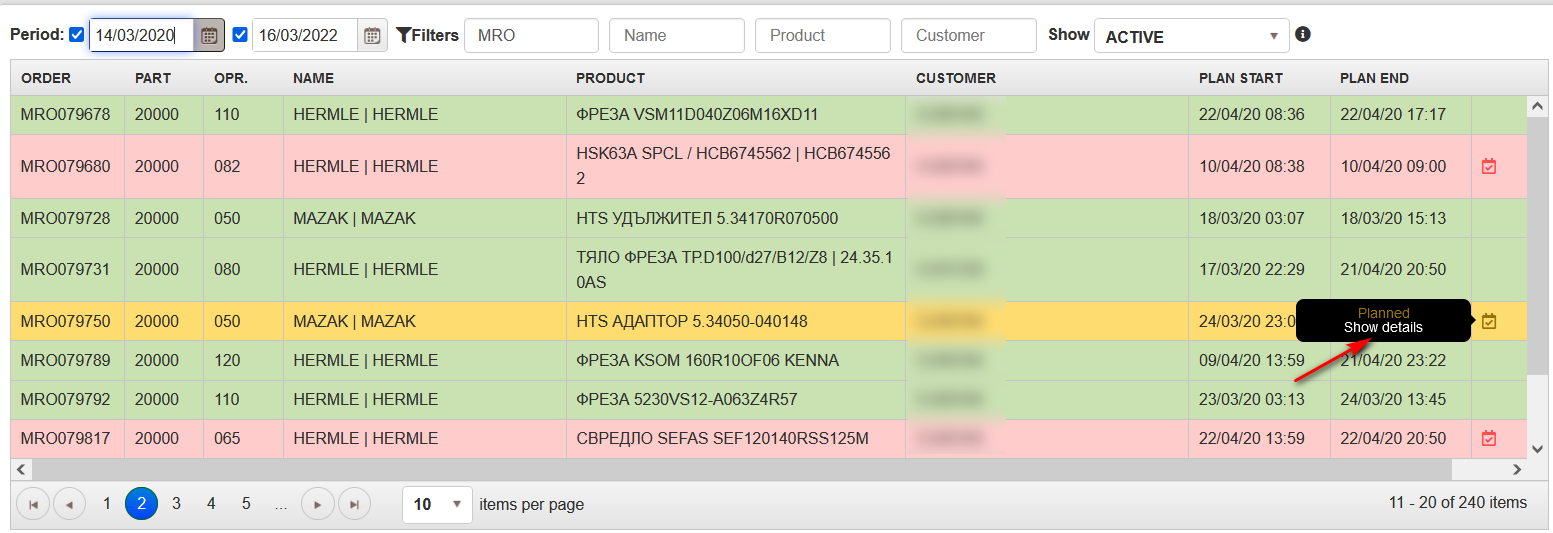
Figure 10: Operations – view details for planned operation
Clicking on the link Show details shows a popup with information

Figure 11: Operations- details for planned operation
In the form with information are shown: machine (number), name (order number), start (start date and time), and duration (hours and minutes).
Clicking on the View button, the production order is located in the plan and bordered with blue color.

Figure 12: Planned orders Gantt – the found order through view details
Production Orders
Purpose: Planning the operations imported from the ERP by dates and machines. The plan with production orders for one machine is displayed in line with orders, sequentially over time.
Select the menu Planning >Production orders
- There is opened page with operations and plan with production orders. The plan is on the bottom part of the page.

Figure 13: Plan with production orders by time and machines
Precondition: To plan the operation for a machine, it should have an assigned shift calendar. View Assign shift template to machine

Figure 14: Plan with production orders for machine
The plan with production orders for a machine is shown on one line. The machine working time is visualized with a white background, nonworking time – with a gray background. The orders are ordered in a machine working time, optionally overtime.
Plan the orders in the machine schedule
Precondition: The machine is selected in the filter. The plan is filtered for the selected machine.
Click on the operation in the operations table that is not planned. Drag down to the plan and drop in the area with the title DROP HERE.
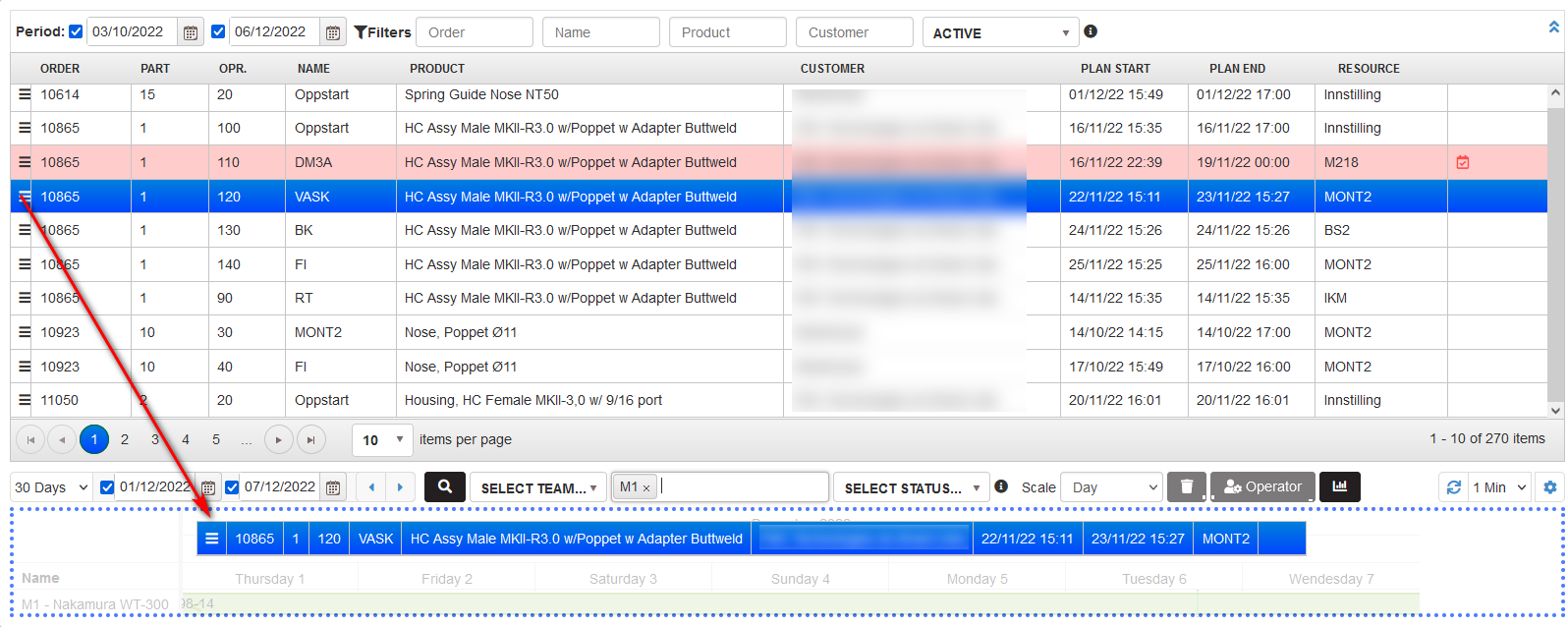
Figure 15: Planning production order
- There is opened the form Create production order:
- Automatically is loaded machine in the form
- Start date and time are loaded with the end date and time of the last planned order for the machine
- Duration shows the operation duration from the ERP with hours and minutes.
- The order Number shows – number of the order-number of the product-number of the operation
- Name of the order – number of the order from the ERP.

Figure 16: Planning – create production order
Click the Save button.
- If the duration of the operation goes outside the machine working time is shown warning with asking the choice how to continue
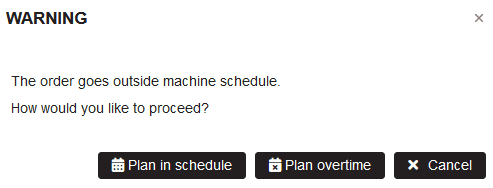
Figure 17: Planning - choice to plan in schedule or overtime on machine
Click the button Plan in schedule.
- The production order is planned only during the working hours of the machine, skipping the non-working hours and breaks. The color of the order reflects its status, according to legend. The non-working hours of the order are displayed with a lighter background.
- The name of the production order in the plan is the order number.

Figure 18: Planning – order planned in machine schedule
The row with the planned operation in the operations table is colored depending on the order status.
Plan the orders overtime
Precondition: The filter with machines is empty. After the last planned order for the machine there is a working time less than the duration of the next planned order.
Click on the operation from the operations table that is not planned. Drag down to the plan and drop in the area with the title DROP HERE.

Figure 19: Planning – plan the order outside the machine schedule
- There is opened the form Create production order filled only with operation duration from the ERP. The duration of the order is longer than the working interval of the machine for the day.
Select a machine from the dropdown list for which to plan the order.
- Automatically are loaded Start date and time equal to the end date and time of the last planned order on the machine.
Click the Save button.
There is opened warning for the choice to plan in schedule or overtime.
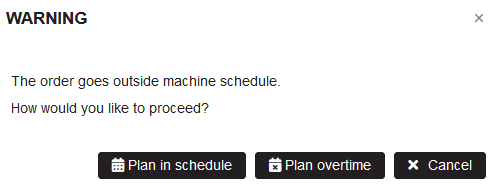
Figure 20: Planning – choice to plan in schedule or overtime
Click the button Plan overtime.
- The whole order will be placed after the last planned order and is also located during the non-working hours of the machine.

Figure 21: Planning – planning the order overtime
View and edit production order
The planned order in the plan with production order is possible to view or update by double click on the order in the plan or single click and click the button Update.
- There is opened the form Edit production order

Figure 22: Planning – edit production order
There is possible to change the machine, the order name, start date and time, and duration of the order in hours and minutes. After clicking the Save button, the changes affect the order plan.
Delete production order
Precondition: There are the planned production orders for the period and machines.
From the plan with production orders are possible to delete only orders with the status Planned or Overdue (but not started).
Click on the order from the plan. The button Delete becomes active. Click on the button Delete.
- The order is removed from the plan with production orders.
- The corresponding operation in the operations table becomes unplanned (white background)
Assign operator to production order
Precondition: There are the planned production orders for the period and machines.
There is possible to assign operators only to production orders with Planned or Overdue (but not started).
Click on the order from the plan. The button Choose operator becomes active. Click the button Choose operator.
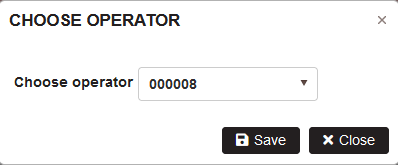
Figure 23: Planed production orders – assign operator
In the Choose operator form select the operator number from the dropdown list. Click the button Save.
- The operator is assigned to the selected production order
If click on the order with status Started or Closed, the buttons are disabled.
Filtering the plan with production orders
Precondition: There are the planned production orders for the period and machines.
Filtering the plan with production orders is possible by machines. It is possible to select more than one machine in the filter.
- In the plan are shown only lines with production orders for the selected machines

Figure 24: Plan with production orders – filtering by machines
Filtering the plan with production order is possible by period. There is possible to filter only by start date, only by the end date or by both dates.
When checked and selected only first date or only second date, in the plan are shown 7 days after the start date or before the end date.

Figure 25: Plan with production order – filtering by period
When trying to select a period greater than 7 days is shown warning with a recommendation to select a smaller period. This is related to the visualization of the days in the plan.
There is possible to change the scale of the plan by selecting hour, day, or week. As a result, the plan is displayed at the selected scale.
Move to the next or previous planned period
Purpose: To select small (up to 7 days) or large (up to 30 days) to show the Gantt planning. Easily to review the plan by moving to the previous or to the next days defined by the filter.

Figure 26: Planning - change max days or move to the next/previous period
There is possible to view a small period (up to 7 days) from the plan. Using arrow is possible to review previous or the next days defined by the From-To dates.
There is possible to view and define a larger period (up to 30 days) and also move to the next or previous period.
Plan the production orders depending on match of cutting tools or clamping device
Purpose: When the last planned machine order is selected in the plan, in the operations table are displayed icons showing the match of cutting tools and clamping device or the number of changes of the cutting tools and/or clamping devices.
The aim is to plan sequentially as production orders operations with a minimum number of changes, to optimize the time for changing cutting tools and clamping devices.
Precondition: There are the planned production orders for the period and machines.
Select the menu Planning > Production orders.
- There is opened page with operations and plan with production orders. The plan is on the bottom part of the page.
In order to perform calculations for matches of cutting tools and clamping devices and display icons, it is necessary to select an option (checkbox) to enable the calculation of matches on the right side of the table with operations.
 Figure 27: Planning – Calculate the matches for cutting tools and clamping devices
Figure 27: Planning – Calculate the matches for cutting tools and clamping devices
When this option is selected and the production order is clicked (selected), matching icons are displayed in the last column of the list with operations.

Figure 28: Planning – calculation of matches of cutting tools and clamping devices
With the icons for matching of cutting tools and clamping devices shown, the planner can choose from them and plan further production orders, minimizing the time to change the cutting tools and clamping devices.
If changes of cutting tools are necessary, a blue icon with a number indicates the number of changes of the cutting tools required for the respective operation.
If changes of clamping devices are necessary, an orange icon with a number indicates the number of changes of the clamping devices required for the respective operation.

Figure 29: Planning – the number of clamping devices to swap

Figure 30: Planning – the number of cutting tools to swap
Plan with production orders – automatic positioning of the orders
Precondition: For one machine, production orders are sequentially planned over time.
Purpose: To maintain the plan with production orders for the machine one after the other. In case of changes in the duration of the planned order, those after it are automatically rearranged.
In case of changes in the orders in ERP as re-planning, the changes are reflected in the plan as order duration changes and the next orders will be automatically rearranged.
When checking downtime for the machine in the ERP and shifting the current order with the duration of downtime the next orders are automatically rearranged. Only started or closed orders are not moved.
Automatic positioning of the orders for machine is possible after the following actions:
- Manual changes of the order
- Re-planning the operation in the ERP
- Logs for produced details in the ERP
- Logs for downtime in the ERP
Automatic positioning of the orders after manual changes to orders
Precondition: For one machine, production orders are sequentially planned over time.
Purpose: In case of manual changes in one planned order, such as duration, the next orders after it with the status Planned or Overdue (but not started) are automatically rearranged one after the other.
We have the following orders for the machine.

Figure 31: Planning – order duration changed – all orders after it are automatic positioned
We open the first order with a double click. The Change Production Order form is displayed. Increase the duration of the order and click Save and then Plan in schedule.
- The duration of the first order is increased
- The orders after it with the status Planned or Overdue (but not started) are automatically moved and rearranged in the plan.
- The orders with the status Started or Completed do not change in the plan
Automatic positioning of the orders after re-planning the operations in the ERP
Precondition: For one machine, production orders are sequentially planned over time.
Purpose: After re-planning the operation in the ERP, in the plan the duration of the corresponding production order is updated according to duration in the ERP. After it, all planned or overdue (but not started) orders are automatically rearranged in sequence.
After rescheduling the operation in the ERP, the planned times are synchronized in Upkip.
If the operation is planned for a machine as a production order, it is updated in the plan with the new duration from the ERP.
The planned or overdue (but not started) orders after the changed one are automatically rearranged in the plan with production orders.
The Started or Completed orders are not changed in the plan.
Automatic positioning of the orders after logs for produced details in the ERP
Precondition: For one machine, production orders are sequentially planned over time.
Purpose: In the production order plan, when an order has been completed, to show the actual duration of the order. After that, all planned or overdue (but not started) orders are automatically rearranged in sequence.
The actual start of a production order is determined from the time of the first log of manufactured parts in the EPR.
The end time of a production order is determined by the end time of the actual log for manufactured parts in the ERP when progress is 100%.
The completed order in the plan is presented with the actual duration of the work.
After that, all planned or overdue (but not started) orders are automatically rearranged in the production order plan.
The Started or Completed orders are not changed in the plan.
Automatic positioning of the orders after logs for downtime in the ERP
Precondition: For one machine, production orders are sequentially planned over time.
Purpose: In the production order plan to show the periods of downtime of the machine, which are determined by the checked start and end in the ERP. The duration of the order should be shown in the plan, excluding the periods of downtime.
When the end of a production order is moved due to downtime, the next planned or overdue (but not started) orders are automatically rearranged.
The actual start of a production order is determined from the moment of the first log of manufactured parts in the EPR.
During machine downtime, the ERP checks are made for the start and end of the downtime. The downtimes are automatically imported into Upkip with their reasons.
In the production order plan, the downtime is visualized in a darker color. On mouse over the drown downtime in the plan, the tooltip with downtime reason is displayed.
Planned Capacity
Precondition: There is created plan with production orders for machines.
Purpose: The planned capacity of machines per days show the percentage how much of the machine’s available hours are busy with production orders:
The planned capacity page shows:
- Capacity percentage of planned hours with production orders on machine vs available machine time per day.
- For each day and machine are shown as heat map percentages, planned, available hours, and the number of orders
- The planned capacity is for the selected period and list of machines. Machines could be filtered.
- Selected machines can be grouped and the chart will show the summary capacity percentage per day.
Select the menu Planning > Planned capacity.
- The Planned capacity page is opened.

Figure 32: Planned capacity initial
Filters for showing the planned capacity.

Figure 33: Planned capacity filters
To show a chart with planned capacity per day select:
- Start and end of the period
- Optionally can be selected team and the machines in the next filter are filtered for the selected team
- Select machines from machines filter
- Click the Search button
- The chart with planned capacity of machines per day is shown.
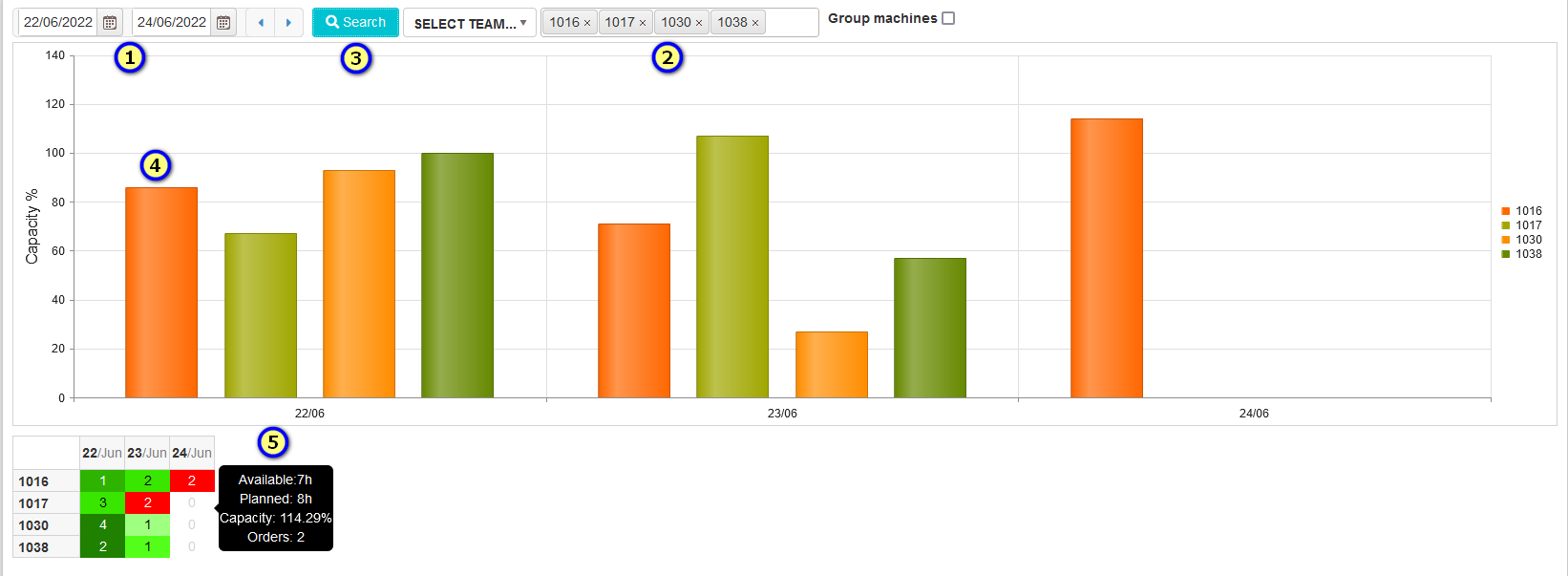
Figure 34: Planned capacity for the selected period and machines
The planned capacity of each machine is shown as a bar per day (4). The capacity percentage is shown on the mouse over the bar.
Under the graphics is shown a table as a heat map.
- Horizontally - dates from the selected period and vertically the list of selected machines.
- Each cell has a gradient color showing machine capacity per day. The colors are from light yellow (small capacity) to red (greater than 100%)
- With the mouse over the cells is shown tooltip with information (5) – available hours, planned hours, capacity, and number of orders.
Calculation of planned capacity for machine:
Machine planned hours per day are equal to the sum of production orders duration planned on the machine per day. (see Planning production orders)
Machine.PlannedHoursPerDay += OrdersDurationOnManiche[i]
Machine available hours per day are taken from the shift calendar assigned to the machine. (see Machine calendars)
Machine.AvailableHoursPerDay = MachineWorkinghoursDurationPerDay
MachinePlannedCapacity [%]= MachinePlannedHoursPerDay / MachineAvailableHoursPerDay
To show the summary capacity percentage of the selected machines check Group machines.
- For each day from the select period is shown one bar with a summary capacity percentage per day.
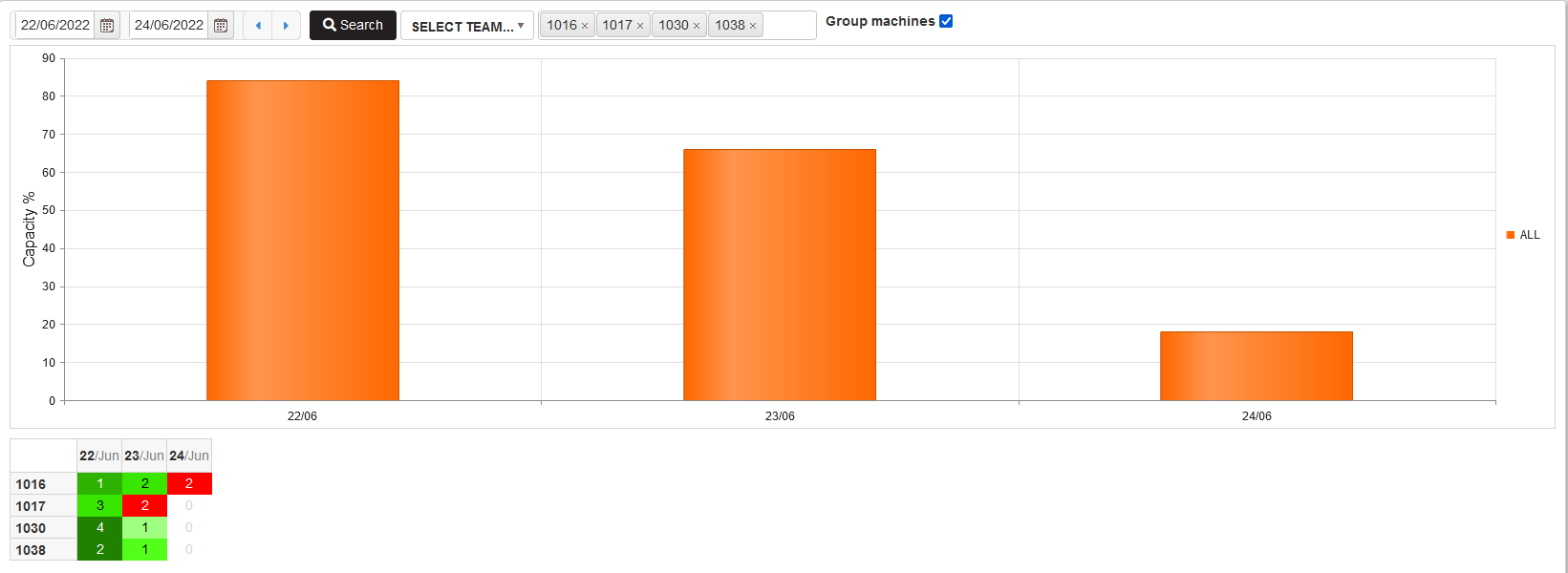
Figure 35: Planned capacity for group of machines per day
Calculation of Summary capacity percentage per day.
- AllPlannedHoursPerDay += Machine[i].PlannedHoursPerDay
- AllAvailablehoursPerDay += Machine[i].AvailableHoursPerDay
SummaryMachinesCapacityPerDay [%] = AllPlannedHoursPerDay / AllAvailablehoursPerDay
Move to the next or previous days with the period filter.

Figure 36: Capacity planning - move to next or previous period
After defining the period, selecting the machines and clicking the Search button is shown a chart and heat map table with the planned capacity for machines for the selected period.
Using the left and right arrows is possible to move to the next or previous period range. In this way, the user can easily review machines’ capacity planning for different periods.
Assistant
Precondition: Operations are planned as production orders for machines over time.
Purpose: To support the user with role Shift leader in his work.
- View planned production orders for the selected day by machine
- Generates and exports (pdf) report for cutting tools and clamping device for machine, order, and operation
- Automatically upload CNC programs to configured machine folders
- Tracks the progress of the order and the numbers of produced details - good and scrap
- View or add operator logs for operation time and produced numbers of details
Select the menu Planning > Assistant.
- The Assistant page is opened
Select date and click the button Get orders.
- A list of planned production orders for the selected date is displayed.
List with planned production orders
Orders are displayed in a table with columns related to the order - order (number), prod. item (number), operation (number), machine (number), start (start date and of the order), duration (order duration in HH:mm).

Figure 37: Assistant – tracking production orders by date and machines
The next 4 columns of the table are for operations that are performed by clicking on the icons.
- Tool Report – generate and export (pdf) report for cutting tools and clamping device for machine, order, and operation
- Load program – automatically upload a CNC programs for the machine
- Timetracking – link to page Register progress for the respective operation
- Plan – Open the page Production orders, find and border with blue color the responding order.
The last column shows the progress of the order - Percentage of progress, X / Y details, where X - actual produced units, Y - planned units, (
Report for cutting tools and clamping device for machine and operation
Purpose: Generate a report for cutting tools and clamping device for the machine, order and operation.
By clicking on the icon from the Tool Report column for the respective order, generates and opens the report Cutting tools for machine, order, and operation.
Precondition: The Assistant page is opened. List of orders for selected date are shown.
For the selected order, click on the icon in the Tool report column.
- There is opened Cutting tools report for machine, order and operation
- There is possible to export the report in PDF format
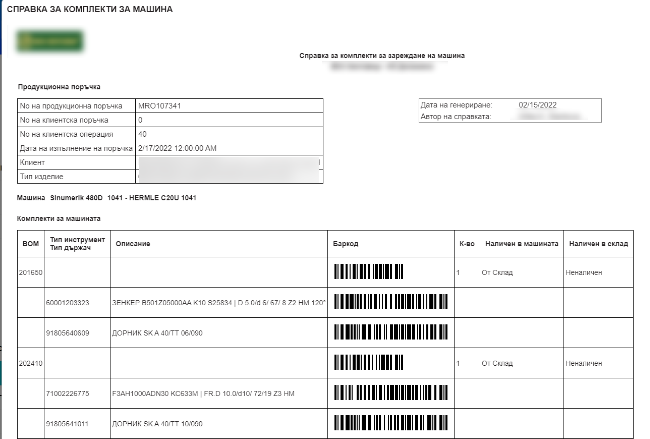

Figure 38: Cutting tools and clamping device report for operation and machine
We have a list of cutting tools and clamping devices for machine, order and operation planned in the ERP and imported into Upkip. We have periodically import.
The columns
The columns „Available in machine“ and „Available in stock“ are important.
„Available in machine“:
- If "-" is set, this means that the available cutting tool/clamping device in the machine must remain for the order
- If it is “To remove”, this means that the tool/clamping device in the machine must be removed from the machine
- If it is “From stock”, this means that the tool/clamping device must be taken from stock
The next column “Available in stock” is important for this option:
- Available – this means that the cutting tool is available in the stock can be taken from the stock
- Unavailable – this means that the cutting tool is not available in the stock and cannot be taken from the stock.
After showing the report on the screen click the button Export PDF.
- The report is generated as PDF file that is downloaded on the local computer.
Upload CNC program on machine
Purpose: Upload a CNC program for machine operation (production order) on the configured folder on the machine.
Precondition: On the page Assistant are shown production orders for the selected date.
The planning of the CNC programs is doing in the ERP. Configuring the CNC program path is done in the organization structure/machine/properties.
By clicking on the icon in the column Load Program for the selected operation and machine, the CNC program automatically is uploaded in the configured machine folder.
For the selected production order click on the icon in the Load Program column.
If the CNC program has found and uploaded successfully is shown a warning for the successful upload.
If there is not found configured CNC program for the operation is shown a message that program not found.
After successful upload of the programs for operation and machine under the icon is shown upload date and time.
To successfully upload of the CNC programs for operation and machine is necessary:
- In the ERP to be configured routes to corresponding CNC programs for operation
- The configured routes are imported in the Upkip
- In Organization/Machines, for each machine is added in properties CNC program upload location.

Figure 39: Machine properties – configuring CNC program upload location
Register Progress
Purpose: Review of the operator logs for produced good or scrap quantities for operation.
Precondition: On the page Assistant are shown production orders for the selected date.
For the selected order click on the icon in column Timetracking.
- The Register progress form is opened with loaded records for produced details (if any)
Data are shown in a table with columns: operator, machine, order (number), position (number), part (description), operation (number), start (date and time), end (date and time), good, scrap.

Figure 40: Register progress – reported time and units from the operator for the order
By clicking on the cells in the columns Good and Scrap for the respective order, user can make the adjustments of the numbers and save by clicking on the Save button.
- The numbers of the good and scrap are saved
The user with the role Shift Leader is possible to add records for produced units from the operators for the orders by clicking on the Add button.
- The form Add is opened
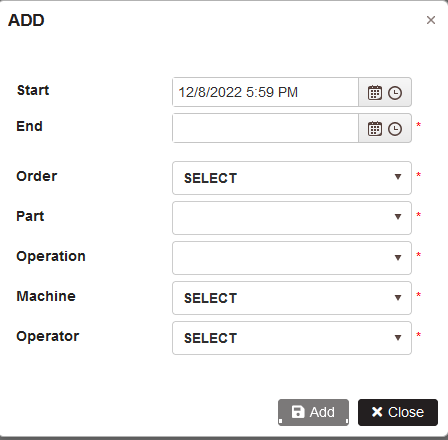
Figure 41: Add records for produced details from operator for order with start and end date and time
Select start and end date and time, operator, machine, order, operation and part.
Click Add.
- A row with operator log for produced details is added.
Enter the numbers for good the scrap details and click Save.
- The record with working date and time and produced details from the operator is added.
Select a row with working time and produced details from operation. Click Delete.
- The record is removed from the table.

Figure 42: Register progress – deleting record